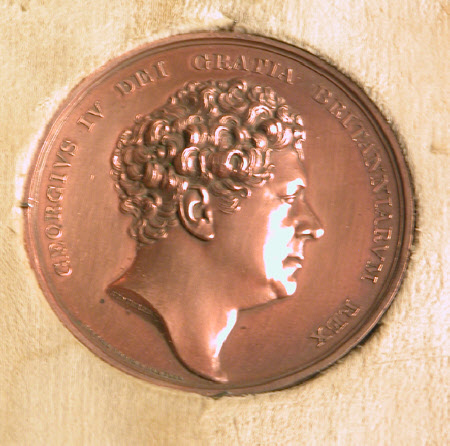Medal commemorating the restoration of Windsor Castle
Alfred Joseph Stothard (London 1793 - London 1864)
Category
Coins and medals
Date
1828
Materials
Bronze
Measurements
6.4 mm (Depth); 72.4 mm (Diameter)
Place of origin
London
Order this imageCollection
Anglesey Abbey, Cambridgeshire
NT 517662.5
Summary
Bronze, Medal commemorating the restoration of Windsor Castle, Alfred Joseph Stothard (1793-1864), London 1828. A bronze medal designed by Alfred Joseph Stothard, commemorating the restoration of Windsor Castle. The obverse has a bust portrait of King George IV facing right, with the legend translated as ‘George IV by the Grace of God King of Britain.’ The artist’s signature on the truncation. The reverse has a view of Windsor Castle, including the Round Tower and the George IV gateway, featuring some of the improvements that had been carried out since work had started in 1824. In the exergue is a phoenix, symbolising the rebirth of the building and an inscription commemorating the king’s championship of the project. Although the works were to continue until 1840, the medal commemorated the completion of the first phase, King George IV moving into his new Private Apartments on 9 December 1828. Mounted in a frame with ten other medals and tokens commemorating and celebrating King George IV (1762-1830, reigned 1820-30) (NT 517662). This particular medal reflects Lord Fairhaven’s particular interest in Windsor Castle, of which he assembled an enormous collection of views in the form of paintings, drawings and prints.
Full description
The medal was made to commemorate the completion of the first phase of the remodelling of Windsor Castle, George IV’s principal residence for the latter years of his life. The castle had hardly changed since the time of King Charles II when, in 1823, George IV decided to make it his residence. Parliament voted £150,000 in 1824 for its remodelling, which was carried out by Jeffry Wyatt (Wyatville). The works ran well over budget, eventually costing more than £1m., and were not completed until 1840. The reverse depicts some of the visible improvements to the Castle made during the first phase of the project, from 1824 to 1828: the raising and crowning of the Round Tower; the Gothicising of the buildings of the Upper Ward; the completion of the new King George IV gateway, created through a duplication of the existing York Tower. The medal consciously celebrates George IV’s role in championing the restoration works, so the monarch appears here both as client and as patron. It is sometimes found in uniface form, as the lid to gold boxes or to boxes made from wood from the timbers of the old castle. There is a box of this type for example in the Royal Collection (RCIN 9013), whilst another was in the collection of Lord St. John of Fawsley (Christopher Hartop, ed., Royal Goldsmiths. The Art of Rundell and Bridge 1797-1843, exh. Cat., Koopman Fine Art, London 2005, pp. 92, 157, no. 70, fig. 82.) Alfred Stothard was the son of the painter, Thomas Stothard. Trained as a sculptor, he was appointed medallist to King George IV. He was active as a medallist from the 1820s through to the 1840s. Jeremy Warren, 2020
Provenance
Bequeathed to the National Trust by Huttleston Rogers Broughton, 1st Lord Fairhaven (1896-1966) with the house and the rest of the contents in 1966.
Credit line
National Trust Collections (Anglesey Abbey, The Fairhaven Collection)
Marks and inscriptions
Obverse: Legend: GEORGIVS IV DEI GRATIA BRITANNIARVM REX Artist’s signature, on truncation: STOTHARD .F. At bottom edge: RUNDELL BRIDGE & RUNDELL Reverse: Legend: WINDSOR CASTLE FOUNDED BY WILLIAM THE CONQUEROR In exergue: RESTORED BY GEORGE IV / 1828 Artist’s signature, on exergue bar : STOTHARD F.
Makers and roles
Alfred Joseph Stothard (London 1793 - London 1864), designer Rundell, Bridge and Rundell, manufacturer
References
Brown 1980: Laurence Brown, A catalogue of British historical medals 1760-1960, Vol.I. The accession of George III to the death of William IV, London 1980, p. 326, no. 1337 Taylor 1989: Jeremy Taylor, The Architectural Medal. England in the Nineteenth Century, London 1989, pp. 8-9, p. 113, no. 131a Eimer 2010: Christopher Eimer, British Commemorative Medals and their Values, London 2010, p. 167, no. 1202, Pl. 131
